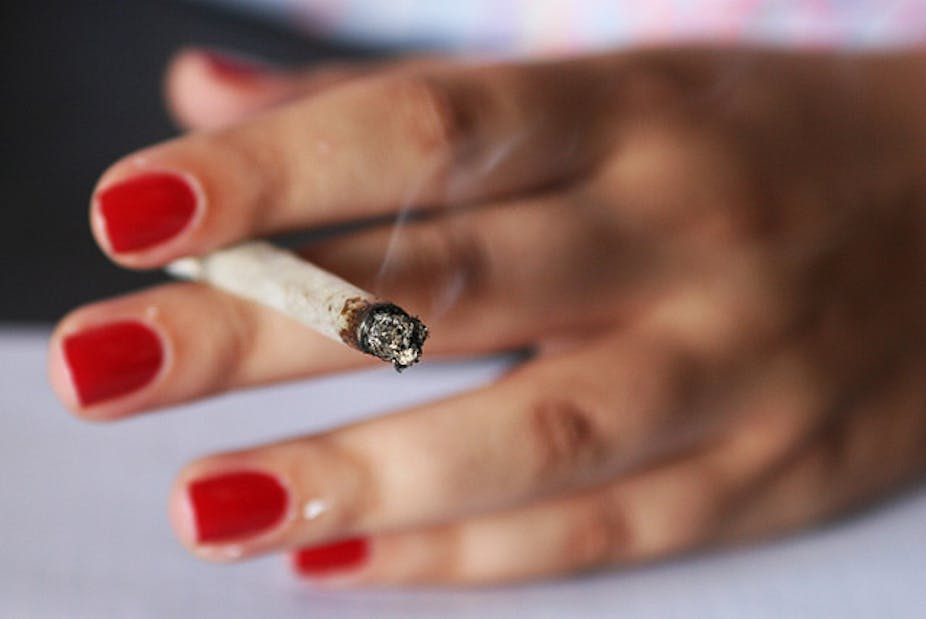Synthetic cannabis is a lab-made product that mimics the effects of cannabis to give users a high when smoked. It has been sold in Australia since 2011 under various brand names, with a range of chemical compositions.
The product presents a unique challenge for drug policymakers. Despite 18 months of legislative action intended to ban synthetic cannabis, people in some states claim they can still walk into a sex store or tobacconist and purchase it. Clearly the legislative changes have not been totally effective.
Who uses synthetic cannabis in Australia?
Last month, we published findings from the first survey of synthetic cannabis users in Australia.
When we asked people why they had first used synthetic cannabis, its legal status was an important reason. While 39% stated that they first tried the product because it was legal, 23% mentioned its availability was important, and 8% mentioned its non-detection in drug testing as a key factor.
We also found that almost all synthetic cannabis users who participated in our study had previously or were currently using cannabis.
Furthermore, evidence from this study and from the wider literature (for example, by Christopher Hoyte and Maren Hermanns-Clausen) indicates that synthetic cannabis products may be as risky as or more risky than cannabis itself. This is due to the lack of information about the ingredients in synthetic cannabis products and the pharmacological profiles of different synthetic cannabis varieties. We have virtually no information about longer term effects of these drugs.
The current state of regulation
A year ago, we published a summary of the legal status of synthetic cannabinoids in Australia. Since then, the Therapeutic Goods Administration (TGA) enacted new laws that prohibited eight broad classes of synthetic cannabinoids as well as any drugs that mimic cannabis.

These laws were intended to capture synthetic cannabinoids that were yet to be identified or even synthesised, in order to put an end to the cat and mouse game, where manufacturers introduce a new product immediately after legislators prohibit an old one.
Despite the TGA laws being ratified six months ago, there does not appear to have been any prosecutions of manufacturers based on these laws to date.
While importation falls under federal legislation, most drug laws are state-based. And while the relevant legislation in some states such as Victoria refers to the TGA’s legislation, the drug laws in other states such as New South Wales do not.
Our advice from law enforcement representatives in these states suggests that prosecution using the TGA’s legislation can only occur in federal jurisdictions (such as border control) and requires involvement by federal agents.
Nonetheless, even in Victoria – where some stores have reportedly had their synthetic cannabis confiscated since the TGA’s laws were ratified – it is unclear whether charges will be laid. Until charges are laid and these cases tried, the impact of the new laws remains unclear.
In another development, Queensland moved to independently implement new legislation redefining a “dangerous drug” as anything intended to “have a substantially similar pharmacological effect” to a banned substance.
But this legislation was not ratified, which meant that Queensland police eventually dropped charges against a number of retailers whose synthetic cannabis was confiscated.
Assessing the regulatory options
Given the ambiguity regarding synthetic cannabis, a NSW parliamentary committee is assessing the regulatory options for newer synthetic drugs. Last month, the committee heard evidence from government officials, industry representatives and researchers.
We outlined the following five possible regulatory options for the committee, while also recognising that the evidence to guide decision-making is limited.

The first is to continue banning individual substances as they become known. This option results in legislation and services playing catch up to an ever increasing array of new substances. A risk is that it may contribute to more harm by driving newer and lesser known products onto the market.
The second regulatory option is to ban broad categories of substances, including ones that activate the same brain systems as currently prohibited substances. But these broader laws have so far not been successfully prosecuted. They also assume that drugs of a similar category or that act on similar parts of the brain have similar harm profiles, when this may or may not be the case.
The third is to use currently available laws for the regulation of medicinal or consumer products, as some experts recently suggested. While this option may have merit, it offers only limited control.
The fourth option is to follow New Zealand’s lead and implement a specific regulatory regime for new psychoactive substances. Under the proposed system, distributors will be required to establish the safety of their products at their own expense before they may be legally sold. This new regulatory regime offers an alternative policy response to mitigate against the harmful cycle of new, untested drugs being sold as “legal highs”, but its success is yet to be established.
The fifth option is to design a new legislative framework that regulates all psychoactive substances. This option is consistent with recent calls for drug law reform. However, the Gillard government has indicated that it will not consider this option, and we still know very little about what the supply, use and harms of synthetic cannabis would look like if cannabis were legally available.
Even though there is no clear evidence to guide policy making in this area, we do know that the emergence of newer synthetic drugs is a complex challenge that requires consideration of all available policy options. We await the recommendations from the NSW Inquiry, due in 2013, which are likely to guide the direction of both state and commonwealth policy reform.

